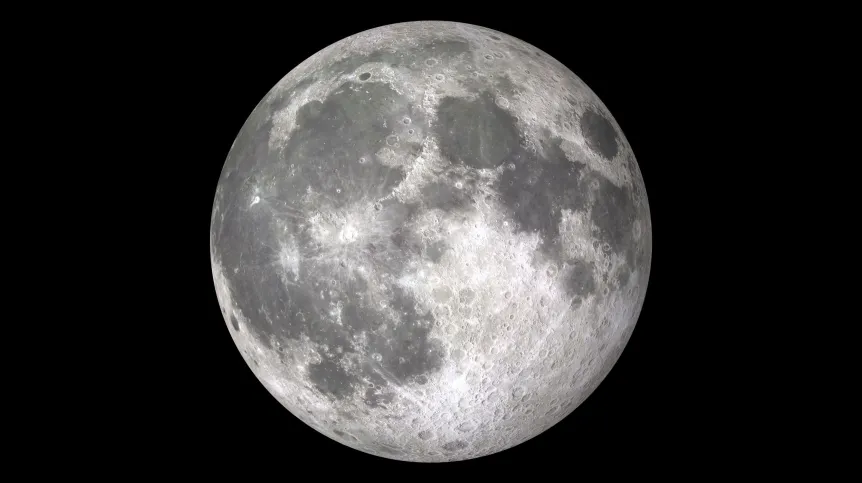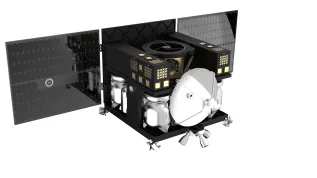
Mining minerals on the Moon is an area where Poland can become a leader in the race for lunar exploration, says Dr. Jakub Ciążela from the Institute of Geological Sciences of the Polish Academy of Sciences. His team has created an instrument that will pinpoint the exact locations of metallic and energy resources on the Moon.
In May, the Polish Space Agency summarized the nearly year-long consultations on the Polish lunar mission. More than 20 entities took part, and the results of their work included four mission concepts. The winning project MIRORES was prepared by the interdisciplinary team led by of Dr. Jakub Ciążela from the Institute of Geological Sciences of the Polish Academy of Sciences.
The project objective is to search for minerals on the Moon.
'First of all, we focus on launching an orbiter mission. We are in talks with the Ministry of Development and Technology. An important criterion in the discussions was the feasibility of the mission,’ said Dr. Oskar Karczewski, director of the Research and Innovation Department at POLSA who was responsible for the sector consultations project regarding the lunar mission.
Scientists will prepare an instrument that will register far infrared radiation. It will be installed on a satellite that will orbit the Moon, about 200 km away from its surface in the first phase of the mission and about 50 km in the second phase. The satellite will also be equipped with an on-board computer, antennas, navigation systems and solar panels. Perhaps there will also be an X-ray spectrometer and an optical camera. The whole project is expected to cost approx. PLN 100 million.
Planetary geologist Dr. Jakub Ciążela said: 'If we want to build bases on the Moon, we need deposits. We have proposed building an instrument that will use far infrared to will detect mineral deposits.
‘We know that some deposit minerals absorb a significant part of this radiation. By recording the emission of infrared rays, we will be able to estimate the size and quality of the deposit. We will find out whether these is 10, 20 or 50 percent of a particular mineral.’
His team has been working on the instrument since 2018. It was originally intended for Mars exploration, but it is universal.
'The geology of the Moon, Mars and Earth is very similar in terms of the set of minerals and rocks. Only their proportions and the conditions in which they can be mined differ. We will particularly focus on searching for ilmenite, which is an oxide of iron and titanium, and troilite, which is an iron sulphide,’ Ciążela told PAP.
He added that the raw materials would not be brought to Earth. An exception may be the helium-3 isotope, which is extremely expensive and valuable from an energy point of view.
When asked what these raw materials will be needed for on the Moon - since they will not be brought to Earth - the scientist said that they will be used in all aspects related to the construction of lunar bases.
Ciążela said: ‘To build bases on the Moon, you need building materials. Concrete is difficult to produce on the Moon because there is not enough water. The water we will find will only be used for drinking. But we will be able to create sulphur concrete - a building material tested on Earth, durable in vacuum conditions and partially resistant to temperature changes that we have on the Moon. Iron and titanium will be needed to built metallic structures - just like on Earth. Gold, silver and copper are excellent conductors.'
According to the geologist, the first community to live on the Moon will function on the basis of modern technologies, and gold, silver and copper will be needed to create conductors.
'Our instrument can also detect oxygen, which can be used as rocket fuel. It is easier to launch a rocket from the Moon, because there is less gravity, and oxygen can be used to carry out flights. Not only return flights to Earth, but also those to more distant parts of the Solar System,’ Ciążela said.
According to the scientist, the only raw material, the transport of which to Earth will be profitable, is a helium isotope, helium-3. Its acquisition on Earth is very expensive, and there is a lot of it on the Moon. It would help solve the energy deficit problems. In France, the construction is already being completed of the experimental fusion power plant ITER, which will use helium-3.
Ciążela continued: 'There is a lot of helium-3 on the Moon, because there is no magnetosphere there and the gas easily reaches the surface. It is captured by a mineral - ilmenite. If we detect ilmenite, we can automatically assume that there is also an increased content of helium-3. If we manage to develop technology for extracting helium and separating helium-3 from helium-4, it will be profitable to bring it to Earth. Here, in turn, it can be used for thermonuclear fusion, thanks to which we will be able to generate large amounts of energy.'
He added that searching for minerals from the Moon's orbit is easier than searching for minerals from the Earth's orbit, because there is no water vapour there.
'There is virtually no atmosphere there. Water vapour interferes with the far infrared, which is why this technology was not developed, because it was not applicable. Only the space industry created such a possibility, because it started to make sense,’ Ciążela said.
The scientist believes that Poland has a chance to create a pioneering project that other countries will follow.
He said: ‘When it comes to searching for raw materials in space, we are one of the leading, or perhaps the leading team. Our strength is an interdisciplinary team (several dozen people), which is not so obvious in the space sector, dominated mainly by physicists and astronomers. Geologists in the team is a new phenomenon, giving a chance to stand out.’
He added that various countries put a lot of effort to finding a niche that will make them a leader in space exploration. The Chinese have already prepared a geological map of the Moon.
He said: ‘So far, most of the efforts have been focused on looking for water on the Moon, and mainly the Americans have specialized in this through the ARTEMIS program. Poland knew that in this area we would not be able to catch up with them. However, the extraction of other raw materials on the Moon is an area where Poland can jump to a leader position.
'NASA can be a strategic partner - be the link between the ARTEMIS program, which aims to find water, and our program, where we focus on the extraction of metals, sulphur, oxygen, helium-3 and gases. But in the end, the results of both programs will be must be connected when designating the construction sites of lunar bases - where both water and energy and metallic resources are present.’
In June, the president of POLSA, Professor Grzegorz Wrochna also spoke to PAP about the need to cooperate with NASA. He said: ‘Of course, we need Americans to deliver this satellite and this was one of the topics of recent talks with NASA Administrator Bill Nelson during his visit to Poland. Nelson could see with his own eyes how the Polish space sector was developing, and cooperation with the American agency is more and more promising.’
In 2021, POLSA signed the Artemis Accords, which paved the way for participation in the Artemis program of manned flights to the Moon. 'We are still in discussions about the goals and technical details of future missions to the Moon and Mars,’ said Wrochna.
The members of the Polish MIRORES team include scientists from the Institute of Geological Sciences of the Polish Academy of Sciences, the Space Research Centre of the Polish Academy of Sciences, Wrocław University of Science and Technology, SKA Polska sp. o.o., and the European Space Foundation. (PAP)
PAP - Science in Poland, Urszula Kaczorowska
uka/ zan/ kap/
tr. RL













